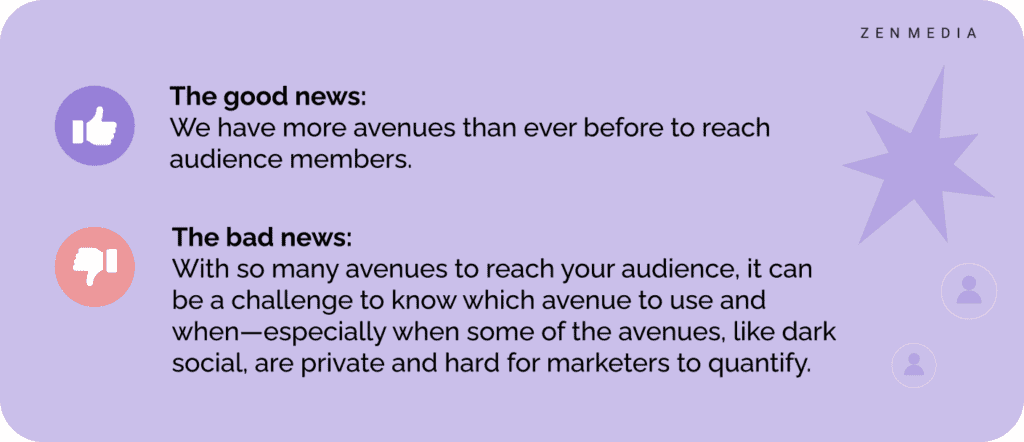The marketing landscape—particularly digital marketing—is constantly changing. There are a lot more requirements than just running an Instagram ad or spamming Facebook posts and calling it a day. You have to stay on top of the latest trends while continually managing your existing efforts.
But let’s face it, keeping up with all of the industry trends can be challenging, distracting, and cost you more than it’s worth if you don’t know how to leverage the trends with staying power and bypass the ones without. Instead of spreading your strategy too thin and placing your eggs in too many baskets, your marketing efforts need to be strategically focused on areas that will have the most impact on your brand and keep you relevant to your customers.
Related reading: Niche Marketing: How Niche Is Too Niche? – Zen Media
The look, feel, and way we approach and execute marketing strategies has evolved significantly over the years, yet the core objective remains unchanged: to reach and engage your audience.
The good news: We have more avenues than ever before to reach audience members.
The bad news: With so many avenues to reach your audience, it can be a challenge to know which avenue to use and when—especially when some of the avenues, like dark social, are private and hard for marketers to quantify.

The “one-size-fits-all” approach just doesn’t cut it anymore. Companies that rely on just one method of reaching their audience are much more susceptible to catastrophe in a changing market, but companies who try to use every pathway at the same time can fall victim to posting for the sake of posting and other marketing faux pas that are derived from a lack of strategy and vision.
Related reading: How To Outsource Your Marketing: Trust Us, We Got This – Zen Media
If you think your marketing strategies aren’t performing as well as they could be, it may be time to assess what’s working and what isn’t and make a concentrated effort to shift your focus to something different. Luckily, we know a few sections you should focus on that data shows will boost your business.
Let’s dive in.
Four Areas You Should Be Focusing Your Marketing Efforts
The User Experience
In today’s digital world, people of all ages have been “trained” to expect more from their interactions with different companies than ever before. This means that the user experience (UX) and customer experience (CX) have to be a top priority in any company’s marketing tactics. Marketers need to think beyond communications and sales support in the traditional sense and pay special attention to the experience both users and customers have and what they expect to receive from giving your business their time and eventually their money.
It’s common to spend lots of time trying to attract people, but that shouldn’t be the end of your marketing—in fact, it’s only the beginning if you really want to turn prospects into long-term loyal customers. There are many elements to look at when constructing the ultimate UX and CX, but the must-haves include:
- A deep understanding of your audience and their needs: The best way to really understand what your customers want—ask them.
- A strong first impression: And by first impression, we mean first several impressions since it takes approximately 27 touchpoints before a prospect converts.
- Straightforward navigation: This can be literal navigation if your company has an app or online platform, or it can refer to the way a service is carried out. Essentially, prospects and customers don’t want any surprises. As soon as they convert, they want to know exactly how to use their new product or how their new business partnership will kick off and progress. At Zen, we provide a game plan for prospects and an onboarding roadmap for new clients. This way, they know exactly what they are getting and how to navigate through our partnership.
- Targeted messaging: Personalization is the name of the game in marketing, and that is why knowing your audience is so vital. If you use general messaging to try and attract a broad audience, odds are you won’t attract anyone because the messaging is so broad that audience members won’t identify with it. Instead of a broad and nonspecific strategy, find your core audience segments and speak directly to them.
Related reading: 9 B2B Web Design Trends for 2022
These days, with the many options competing in the marketplace, buyers won’t tolerate companies that aren’t CX- and UX-focused. You have a short window to show where your priorities lie, and if your buyers feel like you aren’t prioritizing them and their experience, they’ll find a brand that is.
Your Website (Refresh It)
If you go to your website right now, does it reflect the current state of your brand? Does it look inviting and easy to navigate? Does it have a clear and present call to action? If you answered no to any of these questions, it’s probably time for a refresh.
Refreshing your website is one of the most overlooked components of many B2B marketing strategies. In tandem with the user experience, your site can be the most beneficial tool in your marketing kit if you let it. Like your brand itself, it should evolve and change as your audience and services change—just building it is not enough. An old design, outdated information, broken links, or simply unattractive low-quality content could be driving away customers, and you wouldn’t even know! You want to make sure your website remains visually relevant, contains all the key elements needed for success, and, most importantly, helps you generate leads.
In a fast-paced environment with constantly changing trends like the one we all live in, your website can go from being modern and comprehensive to outdated and incomplete pretty quickly. Pay attention to how healthy it is and make sure it is continually being optimized with the best B2B SEO strategies so that search engines can find it.
Your website sits at the center of your online marketing efforts and is a vital and dynamic system that will pay huge dividends in your growth. Make sure it’s working for you the way it should be.
Content Marketing
Yes, content marketing has been a part of marketing efforts for a long time, but it’s now becoming something much more important: Essential.
Both consumers and search engines alike expect businesses to publish new content online regularly, and businesses that fail to are quickly forgotten. To remain visible, creating a regular cadence of content—whether it’s blog posts, social media copy, or video content—is essential. Regular blog content—especially SEO-optimized content—will help your search engine rankings, and regular social media content will help you build a larger audience and create stronger brand awareness.
Ideally, each piece of content plays a part in an overarching B2B content marketing strategy that tells your unique story and helps potential customers decide if they can trust you with their business.
Authority Building
Authority comes from proving your knowledge, expertise, and credibility consistently over a period of time. The first step of authority building is being visible. Visibility leads to brand awareness, and the more aware your audience is of your brand, the more likely they are to trust it, which hopefully leads to conversions.
Of course, the more customers you have, the more your authority grows, which causes a bit of a chicken or the egg question. Do you need authority to make sales, or do you need sales to build authority? The answer is that sales build authority, and authority leads to sales.
But there are more ways to build authority than just making sales.
Strategic public relations is key for authority building because it is a way to validate your company’s credibility or illustrate your C-suite’s expertise. Getting a strong media placement in a trade publication shows others in your industry that your company is worth reading about, and getting a byline opportunity for your company spokesperson helps set them up as a thought leader.
Related reading: The Ultimate Guide to Thought Leadership – Zen Media
Making your marketing efforts match the buyer’s journey
A steady stream of earned media amplified by consistent content marketing strategies will build your authority.
A great website with SEO-optimized content (like a regularly updated blog) will help prospects find your company and learn more about your offerings.
A customer-centric focus will ensure that your messaging, offerings, and the way you partner with your customers will appeal to prospects, compelling them to convert.
Each element connects to the bigger picture—the buyer’s journey and how marketers impact it. At Zen Media, we map our marketing efforts to the buyer’s journey, ensuring that we engage with prospects at the top of the funnel, through the Messy Middle, and down to the bottom of the funnel, where they convert.
This method ensures that you’re putting your eggs in the right baskets and getting a strong ROI for your marketing efforts.
- Purchasing decisions are not made linearly or in a funnel as once believed
- How consumers decide what to buy lies in the “messy middle” of the purchase journey
- Brands must focus on exposure and increasing their share of voice to influence purchase decisions
Need help mapping your strategy to your buyers’ journey? Let’s talk.





